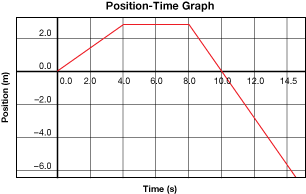Module 1—Motion
Lesson 3—Graphical Analysis of Uniform Motion
 Get Focused
Get Focused

© Marty Symons/shutterstock
Have you ever used a graph to tell a story? Probably not, but graphs are excellent storytellers when it comes to motion. Here is an example.
When the bell rang, Taylor left class. She walked down the hall to her locker, moving at 1.0 m/s. She paused at her locker to grab her coat. Then she ran back towards her classroom, passing it at 2.0 m/s as she made her way to the school exit.

Essentially, this graph tells the same short story. It is a story of motion—of how an object or person changes position as time passes. Graphs are a powerful way to express and analyze the motion of such things as vehicles, trains, satellites, and other moving objects.
A graph can also be used to compare motion, such as that of an athlete. For example, two cyclists are travelling along the same racetrack. They depart at different times and they travel at different velocities. How could you accurately predict where and when they will meet?
one-dimensional motion: motion in a straight line
position-time graph: a graph showing the position of an object at varying times, where time is the independent variable and position is the dependent variable
uniform motion: motion at constant speed in a straight line
velocity-time graph: a graph showing the velocity of an object at varying times, where time is the independent variable and velocity is the dependent variable
In this lesson you will describe and compare one-dimensional, uniform motion using position-time graphs and velocity-time graphs. There are five parts to the lesson. Each part has an essential question for you to answer.
- Part 1: How can you interpret position-time graphs for motion in one dimension?
- Part 2: How do you determine velocity using a position-time graph?
- Part 3: How can you compare observed motions with position-time graphs?
- Part 4: How can you interpret velocity-time graphs for motion in one dimension?
-
Part 5: How do you determine displacement using a velocity-time graph?
Module 1: Lesson 3 Assignments
Your teacher-marked Module 1: Lesson 3 Assignment requires you to submit a response to the following:
-
Try This—TR 1, TR 2, TR 3, TR 4, TR 6, TR 8, TR 10, TR 11, TR 12, TR 13, and TR 14
You must decide what to do with the questions that are not marked by your teacher.
Remember that these other questions provide you with the practice and feedback that you need to successfully complete this course. You should respond to all the questions and place those answers in your course folder.